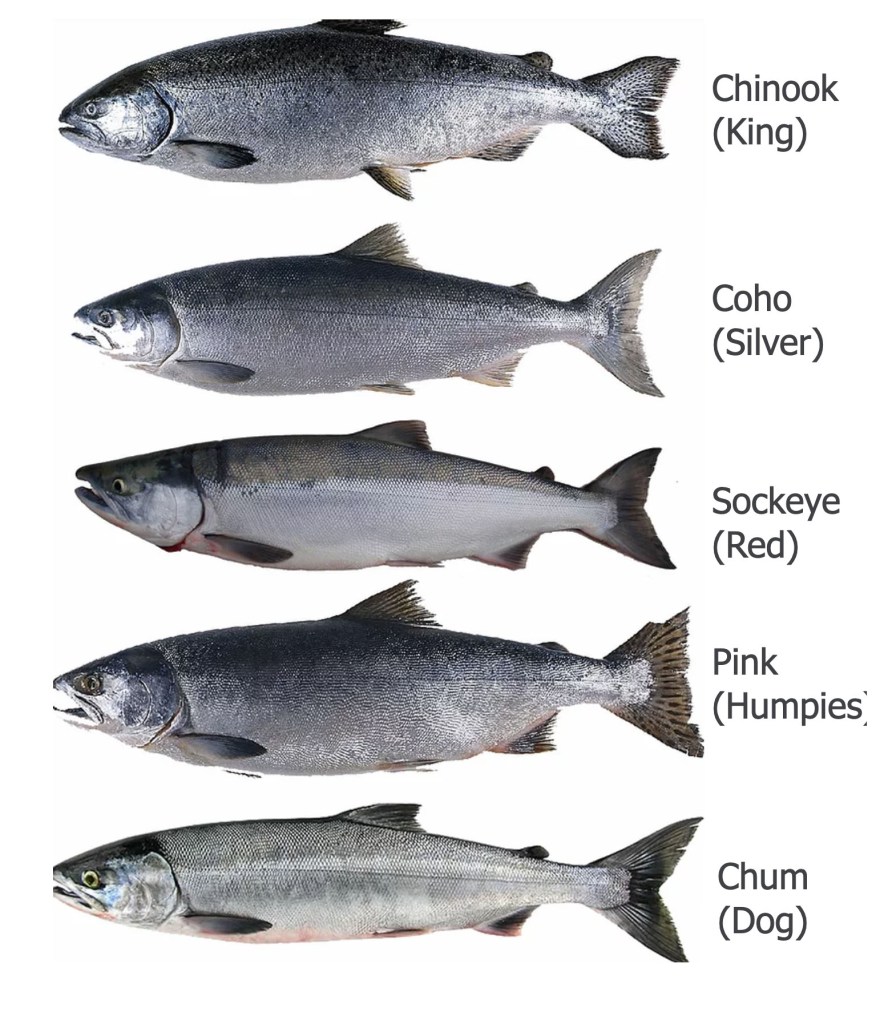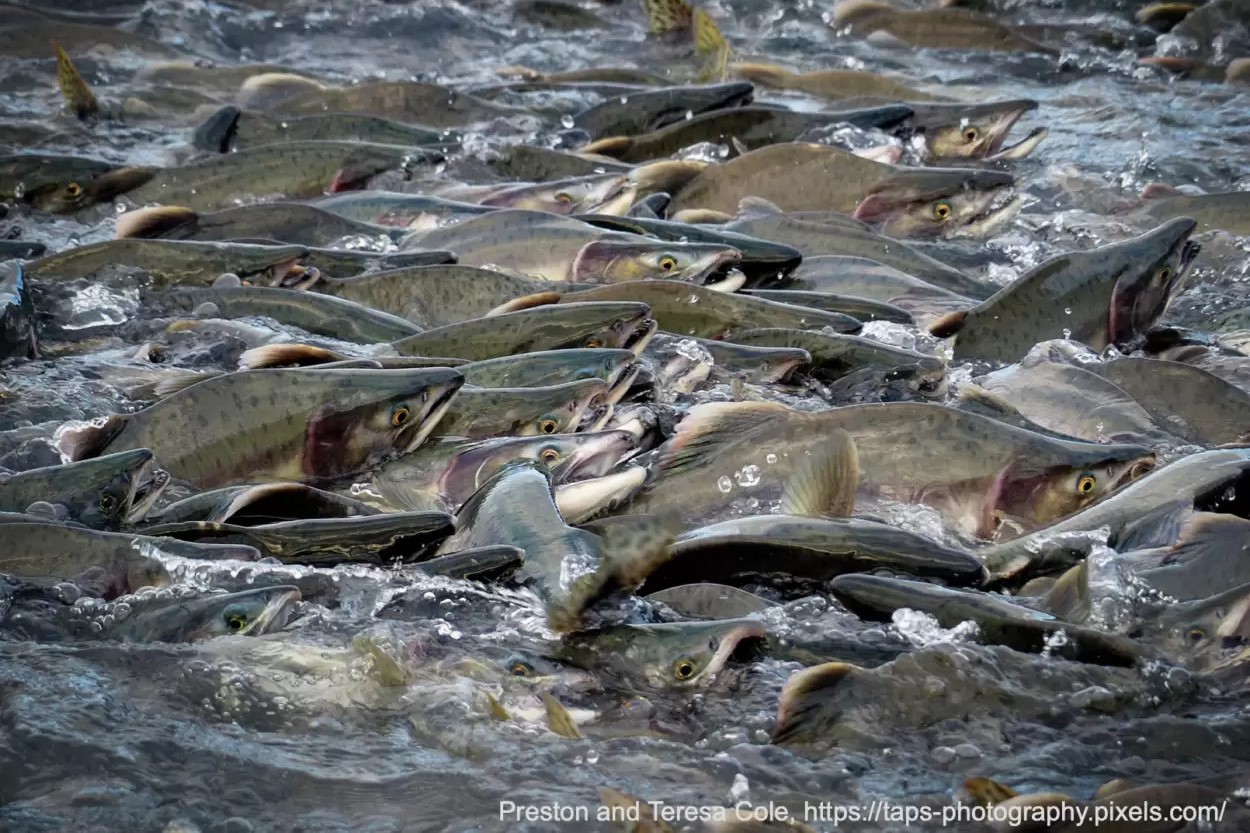Introduction

Alaska is home to a diverse population of salmon, with each species possessing unique characteristics and adaptations. These magnificent fish play a crucial role in Alaska’s ecosystem and economy, with their abundance supporting commercial and recreational fishing industries. From the majestic Chinook salmon, known for its size and strength, to the vibrant Sockeye salmon, famous for its rich flavor, Alaska offers a spectacular array of salmon species. In this article, we will delve into the different types of salmon found in Alaska, exploring their distinctive features, habitats, and contributions to the state’s natural heritage.
Background On The Diverse Salmon Population In Alaska
Alaska is renowned for its diverse salmon population, boasting nine native species of anadromous salmonids. These species include Chinook, Sockeye, Coho, Pink, and Chum salmon. Each species has unique characteristics, adaptations, and behaviors that contribute to the rich biodiversity of the region. Salmon have been a vital part of Alaska’s culture and ecosystem for centuries, serving as a source of sustenance for humans and various wildlife species. The abundance and variety of salmon in Alaska make it one of the most important salmon-producing regions in the world.
Importance Of Salmon To Alaska’s Ecosystem And Economy
Salmon play a vital role in both Alaska’s ecosystem and economy. In the ecosystem, salmon transfer essential nutrients from the ocean to freshwater habitats when they return to their spawning grounds. This process fertilizes the surrounding ecosystems, supporting the growth of vegetation and providing food for other species. Additionally, the carcasses of salmon act as a food source for scavengers and contribute to nutrient cycling.
In terms of the economy, salmon fishing is a significant industry in Alaska, supporting commercial and subsistence fisheries. The commercial fishing sector generates revenue and job opportunities for local communities. Salmon also contribute to the tourism industry, attracting anglers and nature enthusiasts from around the world. The economic value of salmon cannot be overstated, making their conservation and sustainable management crucial for the long-term prosperity of Alaska’s communities and ecosystems.
Chinook Salmon

Chinook Salmon, also known as King Salmon, is one of the most iconic species found in Alaska’s waters. With its distinctive silver skin and large size, the Chinook Salmon is highly prized by both commercial and sport fishermen. These salmon can reach impressive lengths of up to four feet and weigh over 50 pounds. They have a complex life cycle, spending several years in freshwater before migrating to the ocean. Chinook Salmon are known for their powerful swimming abilities and challenging fights when caught on a fishing line. Their rich, flavorful meat makes them a delicacy, sought after by seafood enthusiasts worldwide.
Characteristics And Lifecycle Of Chinook Salmon
The Chinook Salmon, also known as King Salmon, possesses distinctive characteristics that set it apart from other salmon species. These impressive fish can reach lengths of up to four feet and weigh over 50 pounds, making them the largest salmon species in Alaska. With their silver skin and powerful swimming abilities, Chinook Salmon are highly prized by both commercial and sport fishermen.
Chinook Salmon have a complex lifecycle, spending several years in freshwater before migrating to the ocean. After maturing in the ocean, they return to their natal rivers to spawn. This arduous journey, often spanning hundreds of miles, showcases their remarkable resilience and determination. Their rich, flavorful meat is prized by seafood enthusiasts worldwide, making Chinook Salmon a valuable and iconic species in Alaska’s waters.
[7]
Habitat And Distribution Of Chinook Salmon In Alaska
Chinook Salmon are widely distributed throughout Alaska, occupying diverse habitats that range from large rivers to small streams. They prefer colder waters and are often found in deep, fast-flowing rivers with gravel bottoms. These habitats provide suitable conditions for their spawning and rearing activities.
Chinook Salmon are found in various regions of Alaska, including the Arctic, Bristol Bay, the Yukon River, and the Kuskokwim River. They are also abundant in the Southeast and Gulf of Alaska. Their distribution is influenced by factors such as water temperature, availability of food, and suitable spawning grounds.
Overall, the Chinook Salmon’s adaptability to different habitats and their wide distribution make them a significant and iconic species in Alaska’s ecosystem.
Sockeye Salmon

Sockeye Salmon, also known as red salmon, is a species that holds great importance in Alaska’s ecosystem and economy. These fish are known for their distinctive bright red color and firm, flavorful flesh. Sockeye Salmon are well-adapted to both freshwater and saltwater environments, with their life cycle taking them from Alaska’s rivers and lakes to the open ocean and back. They spawn in freshwater rivers and lakes, and their young spend up to two years in freshwater before migrating to the ocean. Sockeye Salmon are known for their exceptional taste and are highly sought after by both commercial and recreational fishermen. These fish play a vital role in supporting indigenous cultures, providing food security, and contributing to Alaska’s thriving fishing industry.
Distinctive Features And Lifecycle Of Sockeye Salmon
Sockeye Salmon, also known as red salmon, have several distinctive features that set them apart. One of their most notable characteristics is their bright red color, particularly during the spawning season. They also have a streamlined body and a deeply forked tail, which enables them to swim swiftly through the water.
The lifecycle of Sockeye Salmon is fascinating. They start their journey in freshwater rivers and lakes, where they hatch from eggs and spend up to two years. Once they reach a certain size, they migrate to the ocean, where they grow and mature. After several years in the ocean, they return to their natal rivers to spawn, completing the life cycle. This epic migration can span hundreds of miles, with Sockeye Salmon jumping over obstacles and battling strong currents to reach their spawning grounds. It is a remarkable feat of resilience and determination.
Key Spawning Grounds And Migration Routes Of Sockeye Salmon In Alaska
Sockeye Salmon in Alaska have specific spawning grounds and migration routes that they follow during their lifecycle. They typically spawn in freshwater rivers and lakes, with some of the key spawning grounds being the Copper River, the Kenai River, and Bristol Bay. These areas provide the ideal conditions for their eggs to hatch and for young salmon to grow. Once they are ready, Sockeye Salmon embark on a remarkable migration back to their natal rivers. They navigate through rivers and face obstacles, such as strong currents and waterfalls, as they make their journey back to their spawning grounds. This migration can span hundreds of miles, showcasing the incredible determination and resilience of these fish.
Coho Salmon

Coho Salmon, also known as Silver Salmon, are one of the iconic species of salmon found in Alaska. They have a distinctive bright silver color with a dark blue-green back and a pinkish or reddish hue on their sides. Coho Salmon have a complex lifecycle, starting from freshwater spawning grounds where they deposit thousands of eggs. After hatching, they migrate to the ocean where they spend 1-2 years feeding on a diet of aquatic insects and small fish. They then return to their natal rivers to spawn and complete their lifecycle. Coho Salmon are widely distributed throughout Alaska, including rivers along the coastline and even in some freshwater lakes. They are highly valued for their sport and commercial fisheries, contributing to the economic and cultural significance of salmon in Alaska.
Overview Of Coho Salmon’s Physical Traits And Lifecycle
Coho Salmon, also known as Silver Salmon, have distinct physical traits and a fascinating lifecycle. They have a bright silver color with a dark blue-green back and a pinkish or reddish hue on their sides. Coho Salmon have a complex lifecycle that begins in freshwater spawning grounds, where they deposit thousands of eggs. After hatching, they migrate to the ocean, where they spend 1-2 years feeding on a diet of aquatic insects and small fish. They then return to their natal rivers to spawn and complete their lifecycle. Coho Salmon are widely distributed throughout Alaska, including rivers along the coastline and even in freshwater lakes. Conservation efforts are vital in maintaining the healthy populations of Coho Salmon.
Different Areas Where Coho Salmon Are Found In Alaska
Coho Salmon, also known as Silver Salmon, are widely distributed throughout various regions of Alaska. They can be found in coastal waters along the entire coastline, from Southeast Alaska to Point Hope. Coho Salmon also inhabit freshwater rivers and lakes, making them a versatile species that can adapt to different aquatic environments. Their ability to thrive in both freshwater and saltwater habitats contributes to their overall population success in Alaska. The diverse range of areas where Coho Salmon are found provides ample opportunities for anglers and wildlife enthusiasts to observe and appreciate these remarkable fish.
Pink Salmon

Pink Salmon, also known as humpback salmon, are a unique species found in Alaska. They have a distinctively humped back and a vibrant pink color. Pink Salmon have a relatively short lifecycle, typically spanning only two years. They are known for their ability to complete their entire life cycle in fresh water, making them an interesting and important species in Alaska’s ecosystem. Pink Salmon are widely distributed along the coast of Alaska, with the exception of the upper Copper River drainage. They have significant commercial significance, contributing to Alaska’s fishing industry. Conservation efforts are necessary to ensure the sustainability of this valuable species.
Unique Characteristics And Lifecycle Of Pink Salmon
Pink Salmon, also known as humpback salmon, have distinct characteristics and a unique lifecycle. They have a humped back and vibrant pink color, setting them apart from other salmon species. Pink Salmon have a relatively short lifecycle, typically spanning only two years. What makes them exceptional is their ability to complete their entire life cycle in fresh water. They are the only known salmon population to have three-year-old individuals. This adaptability allows them to thrive in various freshwater habitats and contributes to the resilience of their population. Pink Salmon play a crucial role in Alaska’s ecosystem and are an important species for conservation efforts. [25]
Abundance And Commercial Significance Of Pink Salmon In Alaska
Pink Salmon are abundant in Alaska, making up a significant portion of the state’s salmon population. They are considered the “bread and butter” fish for many Alaskan coastal fishing communities due to their commercial importance. The Pink Salmon fishery in Alaska is a vital industry, providing jobs and contributing to the state’s economy. These salmon are highly sought after for their delicious flavor and versatility in culinary applications. However, it is important to manage the Pink Salmon fishery sustainably to ensure the long-term viability of this valuable resource.
Conclusion

In conclusion, Alaska’s diverse salmon population is a vital part of the state’s ecosystem and economy. The different species of salmon, including Chinook, Sockeye, Coho, and Pink, each contribute to the ecological balance and provide valuable resources for local communities. However, conservation efforts are crucial to ensure the long-term sustainability of these salmon populations. As human activities and environmental factors continue to impact their habitats and migratory routes, it is essential to appreciate and protect the unique and valuable species of salmon in Alaska for future generations. [29][30]
Conservation Efforts And Challenges Facing Alaska’s Salmon Populations
Conservation efforts are crucial to ensure the long-term sustainability of Alaska’s salmon populations. Efforts are being made to regulate fishing practices, protect spawning grounds, and restore damaged habitats. Government agencies, non-profit organizations, and local communities are working together to implement sustainable fishing practices and promote responsible stewardship of salmon resources. However, there are several challenges facing Alaska’s salmon populations, including climate change, habitat destruction, pollution, and overfishing. These challenges require ongoing research, monitoring, and collaborative efforts to address and mitigate their impact on the salmon population.
Appreciating The Diverse And Valuable Species Of Salmon In Alaska
Alaska is home to a diverse and valuable population of salmon, each with their own unique characteristics and ecological significance. From the iconic Chinook Salmon to the abundant Pink Salmon, these species play a vital role in Alaska’s ecosystem and economy. Their annual migrations, spawning rituals, and nutrient-rich bodies contribute to the balance of the ecosystem and provide sustenance for a variety of wildlife. Additionally, salmon fishing in Alaska is not only a recreational activity but also a major industry that supports local communities and provides jobs. The rich biodiversity of salmon in Alaska is truly something to be appreciated and cherished.
Frequently Asked Questions about Salmon Species in Alaska
Q: What are the different species of salmon found in Alaska?
A: Alaska is home to five primary species of salmon – Chinook (King) salmon, Sockeye (Red) salmon, Coho (Silver) salmon, Pink (Humpy) salmon, and Chum (Dog) salmon.
Q: How can I identify the different salmon species?
A: While all salmon share some common characteristics, you can identify each species based on their distinctive features. Chinook salmon have a black mouth and gums, Sockeye salmon have a bright red body, Coho salmon have dark blue backs with silver sides, Pink salmon have large black oval spots, and Chum salmon have darker vertical stripes and a hooked nose.
Q: When is the best time to see salmon in Alaska?
A: The salmon runs in Alaska vary depending on the species. Generally, the best time to see salmon in Alaska is from May to September. However, specific species may have their peak runs at different times throughout the summer months.
Q: Are all salmon species found in the same areas in Alaska?
A: While some overlap may occur, different species of salmon have their preferred habitats. Chinook salmon are typically found in larger rivers, Sockeye salmon prefer deep lakes and rivers, Coho salmon frequent smaller streams, Pink salmon favor shallow streams near shore, and Chum salmon prefer estuaries and river mouths.
Q: Can I catch salmon for sport or recreation in Alaska?
A: Absolutely! Alaska offers fantastic opportunities for sport fishing. However, it’s important to know and abide by the local regulations and fishing seasons. Make sure to obtain the necessary permits and licenses for fishing before you go.
Q: Are all salmon species good for eating?
A: Yes, all species of salmon found in Alaska are delicious and highly regarded for their flavor and texture. Each species has its distinct taste, ranging from rich and fatty (Chinook) to milder and delicate (Pink). Grilling, baking, or smoking salmon are popular methods of preparation.
Q: Are salmon populations in Alaska stable?
A: The salmon populations in Alaska are closely monitored and managed to ensure their long-term sustainability. The Alaska Department of Fish and Game works diligently to regulate fishing seasons, catch limits, and habitat conservation measures to maintain healthy populations.
Q: Do salmon species in Alaska migrate?
A: Yes, all species of salmon found in Alaska are anadromous, meaning they spend part of their lives in freshwater and part in saltwater. After hatching in freshwater, they migrate to the ocean where they grow and mature. When it’s time to reproduce, they make an incredible journey back to their natal streams to spawn.
Q: Can I spot salmon in Alaska’s rivers and streams?
A: Absolutely! Alaska’s rivers and streams offer incredible opportunities for spotting salmon during their annual migrations. Witnessing these powerful fish in their natural habitat is an awe-inspiring experience and a popular attraction for tourists.
Q: Are there any threats to salmon populations in Alaska?
A: While Alaska has robust conservation measures in place, there are ongoing challenges to salmon populations, such as habitat degradation, climate change, and overfishing. However, concerted efforts are being made to mitigate these threats and protect the long-term health of Alaska’s salmon species.
Q: Can I go salmon fishing in Alaska on my own, or do I need to join a guided tour?
A: It is possible to go salmon fishing on your own in Alaska, but if you are not familiar with the area, it is highly recommended to join a guided tour. Local guides have extensive knowledge of the best fishing spots, regulations, and techniques, ensuring a safe, successful, and memorable experience.

A small, independently run fish and chip shop using quality ingredients cooked freshly in our kitchen to ensure great tasting food. All of our drinks are in glass bottles, and all of our takeaway packaging is recyclable or compostable to help reduce our impact on the environment.